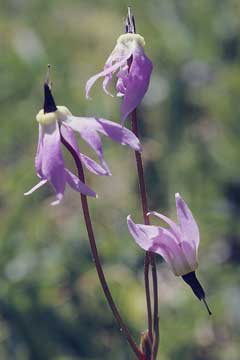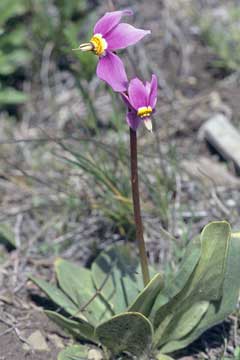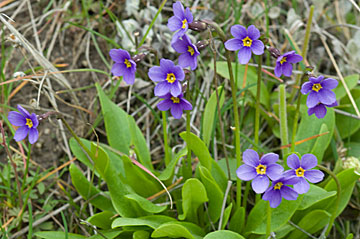
Shooting stars, Dodecatheon spp.
The name Dodecatheon honors the twelve gods of the ancient Greeks; applied in ancient times to a now unknown plant (shooting stars are not found in Eurasia). Although we'll use Dodecatheon here, shooting stars were re-classified in 2007 and are now in genus Primula. They differ from other primroses only in their mode of pollination.
Jeffrey's shooting star, Dodecatheon jeffreyi Van Houtte (left, right). Jeffrey’s, or mountain shooting stars, grow on the banks of mountain lakes and in meadows moist from melting snow. They bloom as high as treeline, often in profuse numbers, from late spring well into summer, according to elevation. The flowers have five (occasionally four) swept back, white-based, pink petals with a yellow collar at the base. Purple-brown anthers join to form a point from which the filament protrudes. Although it may take a hand lens to see it, the stigma at the end of the filament is about twice the width of the filament, a distinguishing feature for this species.


Many-flowered shooting star, Dodecatheon pulchellum (Raf.) Merr. (left) has a squiggly purple ring at the base of the petals as a distinguishing characteristic. The size of the stigma which—unlike that of Jeffrey’s shooting star—is the same diameter as the filament. Shooting stars typically have a rosette of basal leaves whose shape varies with the species. The stem is naked, topped with one to several flowers. . The plant in the illustration, with pale yellow anthers is var. cusickii (Greene) Reveal. The term pulchellum, from the Latin, means “beautiful.”
White-flowered shooting star are occasionally encountered. (right). Although a white-flowered species, Dodecatheon dentatum, occurs in Idaho it isa rare plant. Thhe one shown here seems to be an albino form of Dodecatheon jeffreyi..


Parry’s (or brook) primrose, Primula parryi A. Gray (not shown), is a subalpine plant that grows in moist places in Idaho and in other Rocky Mountain states. We have seen the plant in Colorado, but have not yet encountered it in Idaho. Parry's primrose is considerably taller than Cusick’s primrose—its leaves may be ten inches or more in length and its flowers are blue or purple with yellow eyes.

